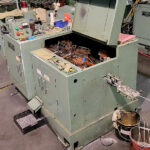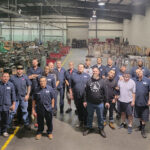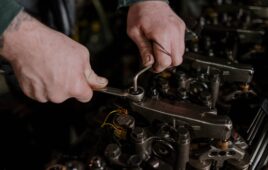~ Article courtesy of RISCO, Inc.
Threadrolling is a manufacturing process that applies threads to the shank of a headed part, such as a fastener. The part is fed into two pieces of tool-grade steel that have been ground with the desired thread dimensions. The threads are formed through machine pressure.
Unlike conventional threading methods like cutting or grinding, threadrolling is a cold-forming process that reshapes the material to form threads, rather than removing it.
All threaded components must first be cold-headed to a specific blank diameter requirement. After any necessary heat treatment, the parts are threadrolled with the required tooling to achieve the finished dimensions.
Threads should also be verified with the following:
- Micrometers, for highly precise linear measurement of the dimension
- Ring gauges, to check the external diameter
- Tri-rollers, for material handling during inspection
- Comparator, a device used to visually compare the dimensions against the reference or standard. This is important to ensure precision and quality control.
Typical threadrollers include flat die machines, tri-rollers, and cylindrical thread rollers. Some common brands are Hartford, Waterbury, and Warren. There are also common foreign machines, such as Saspi (Italy), Darteno (Germany), and Hatebur (Switzerland).
Threadrolling advantages
Threadrolling is commonly used in the production of various fasteners, including screws, bolts, and studs, and other threaded components. This manufacturing method offers several advantages, leading to greater manufacturing efficiency and cost savings.
Additional threadrolling advantages include:
- Structural strength – there is no cutting performed, which can comprise the integrity of the grain structure
- Consistency – ensures highly uniform and consistent thread dimensions, reducing the likelihood of defects
- Greater production – offers fast, high-volume production because it can be performed at approximately 40 to 400 pieces per minute.
- Zero waste – provides material savings, which is beneficial for the environment and a budget
Threadrolling is particularly valuable in applications where thread strength, quality, and reliability are critical, such as the automotive, aerospace, and construction industries.
Material matters
There are important considerations for some materials when threadrolling. For example, softer materials often require less pressure — which can also lead to an improved tool life. Also, certain materials require heat treatment after the threadrolling process, rather than beforehand.
It’s important to note that when initially cold-heading to achieve the blank diameter, softer material might also grow in length after the pressure of the threadrolling dies.
Overall, the choice of material for the part that can also impact the success of the threadrolling process and the quality of the resulting threads.

A die, which is a pre-shaped tool, works with a press to manipulate the material when manufacturing fasteners into a desired size and shape.
Manufacturing matters
As with any manufacturing process, there are potential challenges with threadrolling. It’s imperative the operator properly line up the to ensure there are no laps, cracks, or seams. Monitoring the die wear is also a must to ensure the threads are forming out to the required call-out.
When screening a manufacturer to ensure they’re right for the job, verify that they’re familiar with 2A & 3A thread requirements, have a quality system in place, and have sources that guarantee tooling is made to the exact specifications.











Tell Us What You Think!